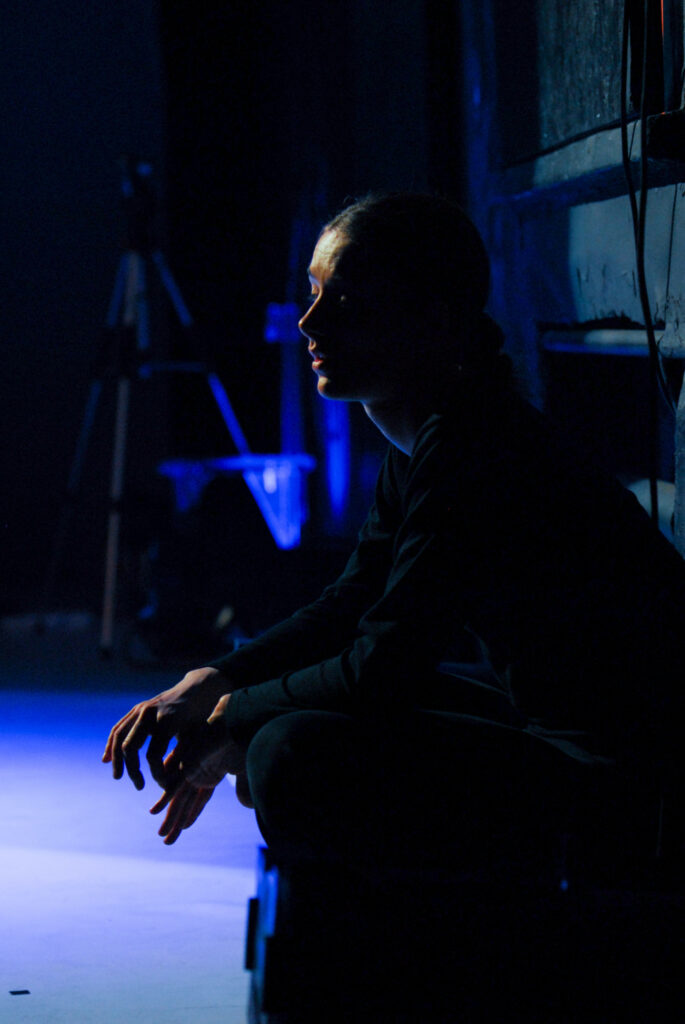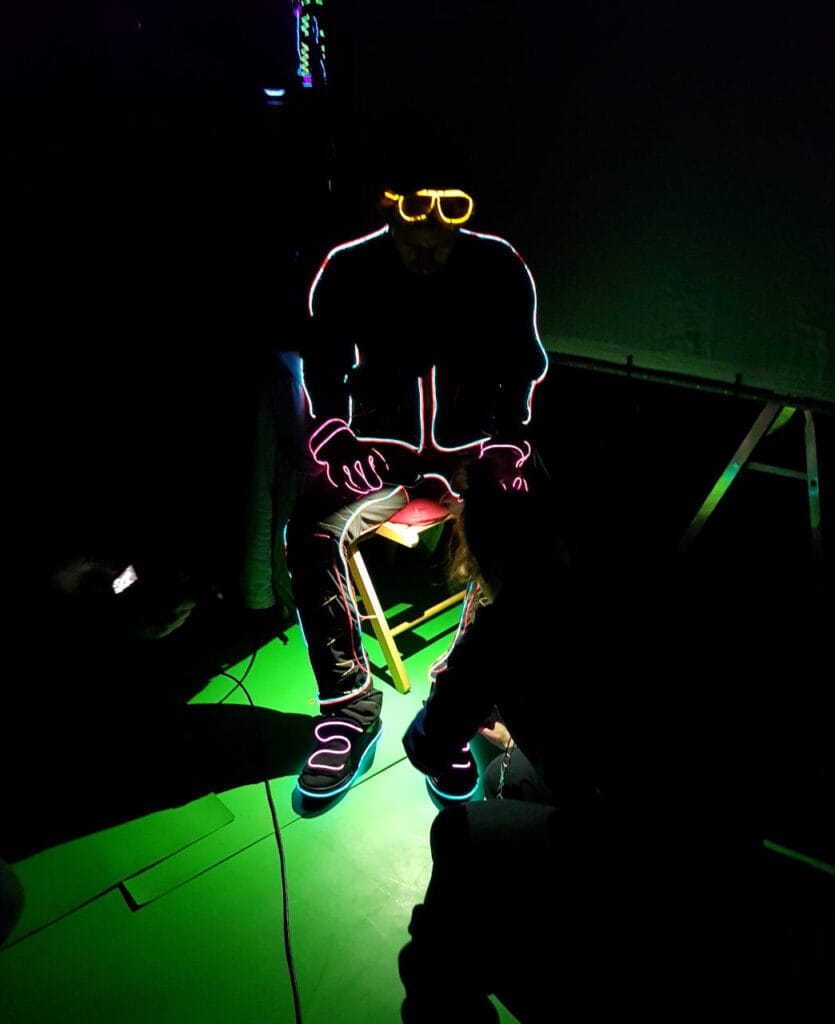Why Use a Blackout Studio?
A blackout studio is, quite simply, a controlled space where light can be introduced with surgical precision. This type of environment is painted black or draped entirely in blackout material, preventing light bounce and minimizing distractions in the background. For interviews or visual podcasting, this means you can highlight your subject with intentional lighting, creating a cinematic and immersive aesthetic.

Benefits at a Glance:
- Lighting Control: Focus light exactly where you want it-on your subject, a backdrop element, or a prop.
- Isolation: Eliminate environmental distractions, ensuring the viewer focuses only on the subject and message.
- Cinematic Look: Emulate the visual polish seen in documentaries, music interviews, and high-end podcasts.
- Sound Optimization: Blackout studios often include sound treatment, providing better audio capture with minimal interference.
Lighting: The Hero of Blackout Studio Production
The key to mastering a blackout space lies in how you use lighting. Without ambient spill or reflective surfaces, your lighting decisions become more noticeable-and more powerful.
For interviews, a three-point lighting setup remains a trusted format:
- Key light: Primary source, often at a 45° angle from the subject.
- Fill light: Reduces harsh shadows caused by the key.
- Backlight: Adds depth, separating the subject from the background.
“Most of the visual impact comes down to lighting decisions. We always recommend creators test their lighting setups the day before filming if possible,” says the gaffer at Soundstage Studios .
Adding practical lights (visible lamps for, ostensibly, aesthetic or decorative purpose) within the frame can offer subtle depth and mood, especially when the subject matter calls for intimacy or artistic flair.
Equipment Placement: Simplified in Blackout Conditions
A blackout studio naturally discourages visual clutter, but planning gear layout still matters. Microphones, cameras, tripods, and lighting stands should be positioned with safety and balance in mind.

Here’s a typical blackout interview setup:
- Camera directly centered or slightly off-axis from the subject
- Key light angled at 45° with soft diffusion
- Boom mic overhead, just out of frame
- Optional LED backlights behind the subject for color accents
Checklist: Before You Shoot in a Blackout Studio
- Charged batteries and backups
- Pre-tested microphones and boom stands
- Shot list, question cards, or storyboards
- High-capacity SD cards or SSDs
- Lighting gels, clamps, and softboxes if needed
- Wardrobe choices that don’t disappear against a black background
Enhancing Podcasts with Visual Appeal
Even if your podcast is primarily audio-first, visuals matter. More platforms (including Spotify, YouTube, and even TikTok) now support video podcasting. A well-lit subject in a blackout studio instantly elevates your production, making episodes more shareable, thumb-stopping, and professional.
The contrast-rich look of a blackout studio suits a range of themes-whether you’re exploring emotional storytelling, deep interviews, or tech reviews. For creators who release both short-form and long-form content, blackout aesthetics can create consistency across formats and episodes.
A Case in Point: From Amateur to Authority
One creator who transitioned their visual podcast setup to a blackout studio saw audience retention climb by over 25%. The reason? Cleaner visuals, tighter audio, and an atmosphere that commanded attention. Consistency in framing and lighting also helped reinforce their brand identity with every episode.
By focusing less on the room and more on the story, creators can guide their viewers into a more engaging experience-one that looks and sounds far more intentional.
Precision and Professionalism for the Modern Creator
For content creators looking to refine their visual style, a blackout studio isn’t just an aesthetic decision-it’s a strategic one. With controlled lighting, audio isolation, and a minimalist background, creators can focus the viewer’s attention exactly where it matters: on the message.
Whether you’re launching a new visual podcast or reimagining your interview series, a blackout studio enables a level of precision and control that home setups often can’t replicate. It’s the environment where ideas become cinematic and storytelling becomes visual craft.

Frequently Asked Questions
What is a blackout studio, and why is it ideal for cinematic interviews and podcasts?
A blackout studio is a specialized filming environment engineered to eliminate all external light and sound, providing total control over your shoot’s atmosphere. This makes it perfect for cinematic interviews and podcasts because it allows creators to focus all attention on the subject, free from ambient distractions. The controlled darkness enables precise lighting setups, resulting in dramatic, high-contrast visuals that highlight facial expressions and details, while the soundproofing ensures clean, professional audio-both crucial for high-quality, immersive content.
How does lighting work in a blackout studio to create a cinematic look?
Lighting is the primary creative tool in a blackout studio. With no ambient light, you can sculpt the scene using techniques like three-point lighting: a key light defines the subject, a fill light softens shadows, and a back light separates the subject from the background. Accent or spotlights can be added to highlight features such as a logo or facial contours, and color gels can introduce mood with subtle tints. Because the background is dark, even small changes in light placement or intensity have a dramatic effect, allowing you to achieve anything from moody, Netflix-style interviews to high-key commercial looks.
What equipment is recommended for filming interviews and podcasts in a blackout studio?
For best results, use cameras with strong low-light performance and manual controls to fine-tune exposure and color balance. High-quality microphones-such as directional, lapel, or boom mics-are essential for capturing clear dialogue and minimizing background noise. LED lighting panels with adjustable brightness and color temperature are recommended, along with softboxes, diffusers, and reflectors to shape and soften the light. Soundproofing materials further improve audio quality, and editing software for color grading and audio enhancement completes the professional workflow.
How does a blackout studio enhance the visual and audio quality of podcasts and interviews?
The absence of ambient light and noise means your subjects stand out crisply against a distraction-free backdrop, focusing the viewer’s attention on their expressions and words. The controlled environment allows for consistent lighting and sound across episodes, reinforcing your brand’s professional aesthetic. Enhanced audio clarity is achieved through soundproofing, while the ability to experiment with lighting leads to visually striking, cinematic results that elevate the perceived value of your content.
What creative options does a blackout studio offer for podcast visuals and interview setups?
A blackout studio lets you experiment with dramatic lighting effects, such as using accent lights to highlight specific decor or faces, or adding colored gels for mood. You can easily switch between different set layouts, from intimate one-on-one interviews to group discussions, all while maintaining a consistent, polished look. The dark backdrop also makes it simple to introduce visual branding elements, like illuminated logos, and to create a signature visual style that sets your content apart. Editing in post-production, such as color grading, further enhances the cinematic atmosphere and ensures each episode looks and sounds its best.
Ready to Take Your Visual Content Further?
Whether you’re developing a branded podcast or building your YouTube presence, Soundstage Studios offers fully equipped blackout studios designed for professional-grade content creation. Our technical staff can support you from lighting setup to post-production advice-ensuring your creative vision comes through with clarity and impact.
Visit Soundstage Studios today to book your next session and elevate your content.

